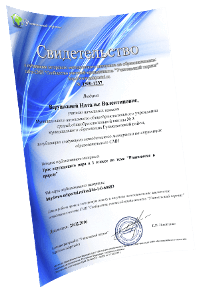|
РАЗРАБОТКИ
|
Статья "Creative Problem Solving"
Учитель английского языка
Абрамова Татьяна Ивановна Гимназия № 426 Санкт Петербург Problem Solving Activities For many years I have been teaching English as a foreign language to different age groups. It isn` t a secret that learning is more effective if the learners are actively involved in this process. We know that students learn a lot by working together in groups to solve a problem or make a decision. Many English teachers think that it is very difficult to use problem solving activities at an English lesson. But did they try? The main task of problem solving activities is to make a student think and express his/her own opinion. To my mind problem solving activities require a creative use of the target language. What is a Creative Problem Solving? Creative Problem Solving ( CPS ) is a process that allows people to apply both creative and rational thinking to find solutions to everyday problems. It uses both convergent and divergent thinking. The Creative Problem Solving Process The Mess Creative Problem Solving is a five- step process. But before starting with the five steps, students must first select a problem. This is usually called “mess finding”. It means that they should select a problem that needs solving. Usually we have more problems than we know what to do with, so it` s a matter of selecting the most pressing one. In this situation, it is most helpful to list all the facts and feelings that are associated with the area of concern. After stating the problem, the students can fill in the facts by answering the questions- who, what, where, when, how and why. When the mess has been defined, they can start proceeding the following five steps in CPS process. 1. Fact Finding In this step, students find all the important facts that relate to the problem. If they don` t have enough information they may ask questions to find out it. Students are looking for answers to the questions Who, what, where, when, how and why. 2. Finding the problem In this step students make several problem statements to define the “real problem”. It is the time to analyze the situation and try to get a better understanding of the problem. They look at the problem from several different points of view and write different “how to” problem statements. 3. Finding ideas They select the best problem statement and think of as many ideas as they can solve the problem. At this step they don` t analyze ideas, but they try to generate a large number of unusual, creative ideas. Students shouldn` t think about whether the ideas are good or bad . They simply select those ideas that seem most workable. 4. Judging ideas. In this step, students choose the most useful idea. To do this, they first determine appropriate evaluative criteria. They should use criteria to select the best idea. 5. Plan of Action In the last step of the process, students outline a plan of action for implementing the idea selected. They also state how they will know if the idea was successful. Creative Problem Solving The Mess Select a problem and record information about the problem 1. Fact Finding Sort out what facts are relevant to the problem and what information is lacking 2. Finding the Problem Analyze the situation and define the “real problem” 5. Plan of Action Plan how to implement the selected solution 4 Judging Ideas Use criteria to select the best idea 3 Finding Ideas Think of creative ways to solve the problem Text “ Hilary` s Pet” Fact Finding Hilary really loves animals- all kinds of animals. At school she always likes to be the person who takes care of the classroom pets. She has cared for a bird, fish, a frog and even a large black spider. Hilary` s birthday is in one month. She is planning a party at the Zoo. Last year she had her party at the skating rink. What Hilary wants most for her birthday is a pet. She would like to have a dog or a cat. She lives in an apartment, and the owner says, “ No pets!”The apartment owner has a parrot that makes a a lot of noise. Another problem is that Hilary` s older sister, Robin, sneezes every time she is around cats or dogs. Hilary thinks that it is very unfair. She promises that she will take good care of the pet. Underline the most important facts that tell about Hilary` s problem and that answer the questions- who, what, where, when, why and how. Finding the problem Hilary would love to get a pet for her birthday. She lives in an apartment that doesn` t allow pets. Her sister sneezes every time she is around cats and dogs. Read all the important facts about Hilary and her pet problem. Then think about what the “Real problem” might be. Write as many ideas as you can by completing this sentence in many different ways: 1. In what ways might Hilary ask to buy her a pet 2. In what ways might Hilary _______( take care of her pet ) 3. In what ways might Hilary ___________( get along with the owner) 4. In what ways might Hilary ___________ Choose the statement that you think best describes the problem. The real problem is___________ Finding Ideas What are all the things Hilary could do to solve her problem? Think of a lot of creative ideas. Write as many ideas as you can. 1.__________( to take care of a parrot) 2.__________( to bring a pet from her school) 3.__________ Judging Ideas Now that you have made a long list of ideas for Hilary, you need to choose the best idea. To do this, you must measure one idea against the others. This is a list of rules that Hilary might use to select the best solution to her problem. 1. The solution should not make her sister sneeze. 2. The apartment owner should like the solution. 3. The solution should give her a chance to take care of a pet every day. 4. The solution should not cost her parents more than $ 50 Ideas sister owner pet $ 50 Choose the idea that you think is the best. My choice for the best solution is ___ Plan of Action Now it` s time for Hilary to put her plan into action. Get help from___neigbours Talk to _____the owner Things to do now _____ Things to do later _____ Things that might go wrong ____ How Hilary will know if her plan is successful ___ Just problems ( situations ) You think that you need a new bike. Your old bike is so small that you hit your knees on the handlebars. Your parents say that they can`t afford a new bike now. They want you to wait until your birthday, but your birthday is nine months away. You don` t want to ride your old bike for nine more months. In new textbooks there are a lot of new words to remember. Some of them are very easy to remember, others are easy to use but some of them are difficult to pronounce. The teacher` s main task is to make the students not only remember all the words but use them in their speech. I always try to find a problem to solve in every task. I ` d like to present you some problem solving activities I use in my lessons. ROBINSON CRUSOE This problem solving activity I use working with words. It helps the students to revise vocabulary on any topic you like. Skills- speaking, writing Other- imagination, fun Language- making suggestions Level- beginners/intermediate Organization- individuals, pairs Preparation- none Time- 7-10 minutes The teacher explains the task to the students. “ You` ve read the book by Daniel Defoe Robinson Crusoe. You remember that one day he had a shipwreck and landed on a desert island. There are many banana trees and coconut palms. The climate is very mild and warm. Make a list of 8-10 things which you think are necessary for your survival” Students work in pairs and compare their lists. Intermediate students should explain their choice ( I take a map to find out here I am…) Give students the ability to solve their problems and you ` ll give them a skill they `ll use for a lifetime. Литература 1. Dianne Draze “Primarily Problem Solving” 2. Газета “English” 7/2002
Всего комментариев: 0
Последние новости образования
Владимир Путин предложил вернуть оценки за поведение в школах Оценивание ОГЭ может быть переведено на 100-балльную систему Сергей Кравцов представил проект расходов по госпрограмме «Развитие образования» на 2025-2027 годы В России предложили ввести штрафы за оскорбление учителей Примерный календарный план воспитательной работы на 2024-2025 учебный год 
В помощь учителю
Уважаемые коллеги! Опубликуйте свою педагогическую статью или сценарий мероприятия на Учительском портале и получите свидетельство о публикации методического материала в международном СМИ. Для добавления статьи на портал необходимо зарегистрироваться.
|
Конкурсы

Диплом и справка о публикации каждому участнику! 
Лучшие статьи
20 интересных фактов о школах в разных странах Сочинение ученика 11 класса «Этот мир многоязычен» Плюсы хорошего поведения в школе Как выбрать кружок для ребенка: Советы для родителей Польза утренней гимнастики для детей Использование нейропсихологического подхода на уроках русского языка Родителям
Эффективные пути педагогического руководства воспитанием школьников в семье. Как повысить успеваемость ребёнка в школе Как воспитать у ребенка любовь к книге и чтению Как привить ребенку желание учиться Консультация для родителей «Эффективный родитель. Ненасильственные методы воспитания детей» |

© 2007 - 2024 Сообщество учителей-предметников "Учительский портал"
Свидетельство о регистрации СМИ: Эл № ФС77-64383 выдано 31.12.2015 г. Роскомнадзором.
Территория распространения: Российская Федерация, зарубежные страны.
Учредитель / главный редактор: Никитенко Е.И.
Сайт является информационным посредником и предоставляет возможность пользователям размещать свои материалы на его страницах.
Публикуя материалы на сайте, пользователи берут на себя всю ответственность за содержание этих материалов и разрешение любых спорных вопросов с третьими лицами.
При этом администрация сайта готова оказать всяческую поддержку в решении любых вопросов, связанных с работой и содержанием сайта.
Если вы обнаружили, что на сайте незаконно используются материалы, сообщите администратору через форму обратной связи — материалы будут удалены.
Все материалы, размещенные на сайте, созданы пользователями сайта и представлены исключительно в ознакомительных целях. Использование материалов сайта возможно только с разрешения администрации портала.
Фотографии предоставлены 